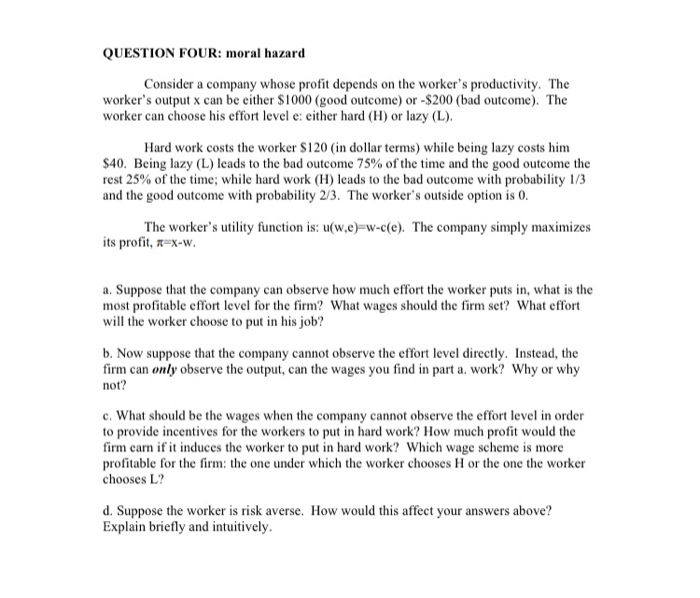QUESTION FOUR: moral hazard Consider a company whose profit depends on the worker's productivity. The worker's output x can be either $1000 (good outcome) or -$200 (bad outcome). The worker can choose his effort level e: either hard (H) or lazy (L). Hard work costs the worker $120 (in dollar terms) while being lazy costs him $40. Being lazy (L.) leads to the bad outcome 75% of the time and the good outcome the rest 25% of the time, while hard work (H) leads to the bad outcome with probability 1/3 and the good outcome with probability 2/3. The worker's outside option is 0. The worker's utility function is: u(w.e)-w-c(e). The company simply maximizes its profit, 1-X-W. a. Suppose that the company can observe how much effort the worker puts in, what is the most profitable effort level for the firm? What wages should the firm set? What effort will the worker choose to put in his job? b. Now suppose that the company cannot observe the effort level directly. Instead, the firm can only observe the output, can the wages you find in part a work? Why or why not? c. What should be the wages when the company cannot observe the effort level in order to provide incentives for the workers to put in hard work? How much profit would the firm cam if it induces the worker to put in hard work? Which wage scheme is more profitable for the firm the one under which the worker chooses H or the one the worker chooses L? d. Suppose the worker is risk averse. How would this affect your answers above? Explain briefly and intuitively. QUESTION FOUR: moral hazard Consider a company whose profit depends on the worker's productivity. The worker's output x can be either $1000 (good outcome) or -$200 (bad outcome). The worker can choose his effort level e: either hard (H) or lazy (L). Hard work costs the worker $120 (in dollar terms) while being lazy costs him $40. Being lazy (L.) leads to the bad outcome 75% of the time and the good outcome the rest 25% of the time, while hard work (H) leads to the bad outcome with probability 1/3 and the good outcome with probability 2/3. The worker's outside option is 0. The worker's utility function is: u(w.e)-w-c(e). The company simply maximizes its profit, 1-X-W. a. Suppose that the company can observe how much effort the worker puts in, what is the most profitable effort level for the firm? What wages should the firm set? What effort will the worker choose to put in his job? b. Now suppose that the company cannot observe the effort level directly. Instead, the firm can only observe the output, can the wages you find in part a work? Why or why not? c. What should be the wages when the company cannot observe the effort level in order to provide incentives for the workers to put in hard work? How much profit would the firm cam if it induces the worker to put in hard work? Which wage scheme is more profitable for the firm the one under which the worker chooses H or the one the worker chooses L? d. Suppose the worker is risk averse. How would this affect your answers above? Explain briefly and intuitively







